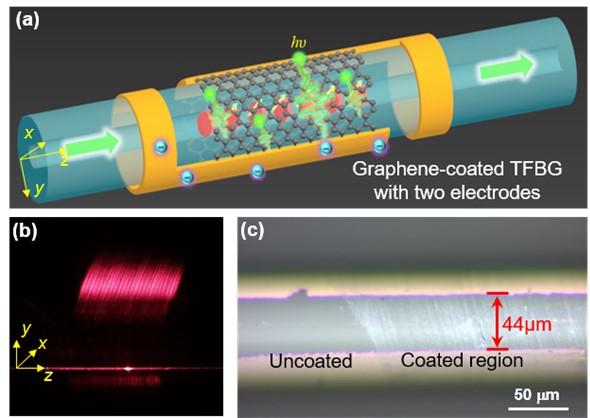| Sep 15, 2023 |
In-fiber photoelectric device based on graphene coated tilted fiber grating
(Nanowerk News) Optical fiber-based devices have become hugely successful for the development, maturity and extensive applications of fiber communication and sensing technologies. However, it has been a challenge to functionalize and sensitize the ordinary silica fibers to detect and convert the light signal travelling through in fibers.
|
|
To solve this issue, especially integrating photoelectric device on optical fibers will be a potential alternative. For instance, the construction of all-fiber photodetectors by bonding two-dimensional (2D) materials or the metasurfaces to optical fiber tips, has the high photoresponsivity and excellent compatibility with the optical fiber system. The graphene or hybrid CNT/graphene film was also integrated on the D-shaped or tapered fibers, and the enhancement of light-matter interaction will help to achieve the photoelectric detection/phase modulation. Unfortunately, the modification and removal of the fiber cladding are required in these devices, which will destroy the integrity of optical fibers and reduce the mechanical properties.
|
|
Tilted fiber Bragg gratings (TFBGs), as a new photonic device, can also provide the strong evanescent field adjacent to the interface of fiber cladding to absorb, modulate, or convert the light signal into the electrical signal in the fibers by integrating the functional materials. Therefore, the combination of the graphene and all-fiber configuration provides a new opportunity for realizing integrated and miniaturized all-fiber photoelectric devices.
|
|
The authors of this article in Opto-Electronic Science ("In-fiber photoelectric device based on graphene-coated tilted fiber grating") report the achievement of an in-fiber optoelectronic device assisted by graphene layer and two symmetrical electrodes for photoelectric and electric-induced thermo-optic conversions, as shown in Fig. 1.
|
 |
| Fig. 1. Graphene-integrated TFBG photoelectric device. (Image: Compuscript)
|
|
In the device, a TFBG is used to provide a strong evanescent field and a multiresonant comb-like spectrum, the few-layer graphene acts as a photoelectric conversion medium as well as a microheater by the electrical injection, and the symmetrical electrodes are used to receive the photocurrent signal or apply the electrical signal. Therefore, the transmitted spectrum from this device consists of a dense comb of narrowband resonances that provides an observable window to sense the photocurrent and the electrical injection in the graphene layer.
|
|
The spectral characteristics and modal distributions of TFBG’s cladding modes are numerically simulated to theoretically verify the polarization-dependent absorption properties of graphene. In the experiment, the P-polarized and S-polarized resonances at different wavelengths are selected for photoelectric response test.
|
|
For the photocurrent generation, the device shows a polarization-dependent photoresponse with responsivity up to 11.4 A/W, saturation photocurrent of around 100 µA and response speed of 196 ms. Moreover, the wavelength-dependent photocurrent evolution allows the comb-like spectrum analysis of the TFBG and demonstrates a higher spectral resolution than the transmission scanned by a tunable laser.
|
|
For the electrically-induced thermal effect, when an electrical signal is applied on the graphene layer, the transmission spectrum of the TFBG will appear a global red-shift due to the electrically pumped Joule heating effect. The spectral shift has a linear response with the square current, and the sensitivity is up to 2.167×104 nm/A2. In addition, the response time and maximal extinction ratio of the thermal-optical switch are 148 ms and 15 dB, respectively, due to the long-distance, homogeneous heat generation and transfer of graphene layer.
|
|
Therefore, with the advantages of all-fiber system, the propagation, filtering, modulation, and detection of the light signal can be realized in a fiber device without loss for integration, which is more flexible than using lens system and fiber coupling system to focus the light source into on-chip waveguide. We believe this work provides a potential pathway to develop multifunctional fiber-based optoelectronic device with 2D material integration.
|

